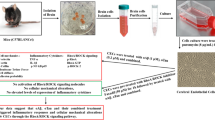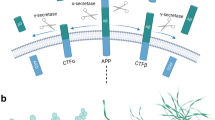Abstract
Amyloid peptide (Aβ) is the major protein constituent of neuritic plaques in Alzheimer's disease (AD). This peptide is an amphipathic molecule that perturbs membranes and binds to raft-like membranes composed of gangliosides. Ganglioside GM1 binds tightly with Aβ and it is speculated that GM1 inhibits Aβ from undergoing α-helix to β-sheet conformational changes. Although the role of gangliosides in conformational changes of Aβ have been studied, the specific nature of these interactions have not been reported. In the present report multidimensional NMR studies of ganglioside-Aβ interactions were conducted in sodium dodecyl sulphate (SDS) micelles, a membrane-mimicking environment. These studies reveal that asialoGM1 binds specifically with Aβ in a manner which could prevent β-sheet formation, but that ganglioside GT1b does not bind Aβ. Plausible pathways for the involvement of gangliosides in amyloidogenesis are discussed.
Similar content being viewed by others
references
Iversen, L. L., Mortishire-Smith, R. J., Pollack, S. J., and Shearman, M. S. 1995. The toxicity in vitro of beta-amyloid protein. Biochem. J. 311:1–16.
Glenner, G. G. and Wong, C. W. 1984. Alzheimer's disease: Initial report of the purification and characterization of a novel cerebrovascular amyloid protein. Biochem. Biophys. Res. Commun. 120:885–890.
Masters, C. L., Simms, G., Weinman, N. A., Multhaup, G., McDonald, B. L., and Beyreuther, K. 1985. Amyloid plaque core protein in Alzheimer disease and Down syndrome. Proc. Natl. Acad. Sci. USA 82:4245–4249.
Kang, J., Lemaire, H. G., Unterbeck, A., Salbaum, J. M., Masters, C. L., Grzeschik, K. H., Multhaup, G., Beyreuther, K., and Muller-Hill, B. 1987. The precursor of Alzheimer's disease amyloid A4 protein resembles a cell-surface receptor. Nature 325:733–736.
Lambert, M. P., Barlow, A. K., Chromy, B. A., Edwards, C., Freed, R., Liosatos, M., Morgan, T. E., Rozovsky, I., Trommer, B., Viola, K. L., Wals, P., Zhang, C., Finch, C. E., Krafft, G. A., and Klein, W. L. 1998. Diffusible, nonfibrillar ligands derived from Abeta1-42 are potent central nervous system neurotoxins. Proc. Natl. Acad. Sci. USA 95:6448–6453.
Geula, C., Wu, C. K., Saroff, D., Lorenzo, A., Yuan, M., and Yankner, B. A. 1998. Aging renders the brain vulnerable to amyloid beta-protein neurotoxicity. Nature Med. 4:827–831.
Muller, W. E., Koch, S., Eckert, A., Hartmann, H., and Scheuer, K. 1995. beta-Amyloid peptide decreases membrane fluidity. Brain Res. 674:133–136.
Arispe, N., Rojas, E., and Pollard, H. B. 1993. Alzheimer disease amyloid beta protein forms calcium channels in bilayer membranes: Blockade by tromethamine and aluminum. Proc. Natl. Acad. Sci. USA 90:567–571.
Yanagisawa, K., Odaka, A., Suzuki, N. and Ihara, Y. 1995. GM1 ganglioside-bound amyloid beta-protein (A beta): A possible form of preamyloid in Alzheimer's disease. Nature Med. 1:1062–1066.
Kakio, A., Nishimoto, S., Yanagisawa, K., Kozutsumi, Y., and Matsuzaki, K. 2002. Interactions of amyloid beta-protein with various gangliosides in raft-like membranes: Importance of GM1 ganglioside-bound form as an endogenous seed for Alzheimer amyloid. Biochemistry 41:7385–7390.
Paola, B. and Sandro, S. 1997. Dynamics and spatial organization of surface gangliosides. Trends Glycosci. Glycotechnol. 9:433–445.
Kohji, K. and Yutaka, S. 2001. Involvement of lipid raft signalling in ganglioside-mediated neural function. Trends Glycosci. Glycotechnol. 13:587–594.
Nagai, Y. 1995. Functional roles of gangliosides in bio-signaling. Behav. Brain Res. 66:99–104.
McLaurin, J. and Chakrabartty, A. 1996. Membrane disruption by Alzheimer beta-amyloid peptides mediated through specific binding to either phospholipids or gangliosides: Implications for neurotoxicity. J. Biol. Chem. 271:26482–26489.
McLaurin, J., Franklin, T., Fraser, P. E., and Chakrabartty, A. 1998. Structural transitions associated with the interaction of Alzheimer beta-amyloid peptides with gangliosides. J. Biol. Chem. 273:4506–4515.
ChooSmith, L. P. and Surewicz, W. K. 1997. The interaction between Alzheimer amyloid beta (1–40) peptide and ganglioside GM1-containing membranes. FEBS Lett. 402:95–98.
Yanagisawa, K. and Ihara, Y. 1998. GM1 ganglioside-bound amyloid beta-protein in Alzheimer's disease brain. Neurobiol. Aging 19:S65–S67.
Ariga, T. and Yu, R. K. 1999. GM1 inhibits amyloid beta-protein-induced cytokine release. Neurochem. Res. 24:219–226.
Kakio, A., Nishimoto, S., Kozutsumi, Y., and Matsuzaki, K. 2003. Formation of a membrane-active form of amyloid beta-protein in raft-like model membranes. Biochem. Biophys. Res. Commun. 303:514–518.
Farrow, N. A., Muhandiram, R., Singer, A. U., Pascal, S. M., Kay, C. M., Gish, G., Shoelson, S. E., Pawson, T., Forman-Kay, J. D. and Kay, L. E. 1994. Backbone dynamics of a free and phosphopeptide-complexed Src homology 2 domain studied by 15N NMR relaxation. Biochemistry 33:5984–6003.
Delaglio, F., Grzesiek, S., Vuister, G. W., Zhu, G., Pfeifer, J., and Bax, A. 1995. NMRPipe: A multidimensional spectral processing system based on UNIX pipes. J. Biomol. NMR 6:277–293.
Garrett, D. S., Powers, R., Gronenborn, A. M., and Clore, G. M. 1991. A common sense approach to peak picking two-, three-and four-dimensional spectra using automatic computer analysis of contour diagrams. J. Magn. Reson. 95:214–220.
Goddard, T. D. and Kneller, D. G. 1994. SPARKY 3, University of California, San Francisco.
Coles, M., Bicknell, W., Watson, A. A., Fairlie, D. P., and Craik, D. J. 1998. Solution structure of amyloid beta-peptide(1-40) in a water-micelle environment: Is the membrane-spanning domain where we think it is? Biochemistry 37:11064–11077.
Roth, G. S., Joseph, J. A., and Mason, R. P. 1995. Membrane alterations as causes of impaired signal transduction in Alzheimer's disease and aging. Trends Neurosci. 18:203–206.
Avdulov, N. A., Chochina, S. V., Igbavboa, U., O'Hare, E. O., Schroeder, F., Cleary, J. P., and Wood, W. G. 1997. Amyloid beta-peptides increase annular and bulk fluidity and induce lipid peroxidation in brain synaptic plasma membranes. J. Neurochem. 68:2086–2091.
Iqbal, K. and Grundke-Iqbal, I. 2002. Neurofibrillary pathology leads to synaptic loss and not the other way around in Alzheimer disease. J. Alzheimers Dis. 4:235–238.
Matsuzaki, K. and Horikiri, C. 1999. Interactions of amyloid beta-peptide (1–40) with ganglioside-containing membranes. Biochemistry 38:4137–4142.
Ariga, T., Kobayashi, K., Hasegawa, A., Kiso, M., Ishida, H., and Miyatake, T. 2001. Characterization of high-affinity binding between gangliosides and amyloid beta-protein. Arch. Biochem. Biophys. 388:225–230.
Op Den Velde, W. and Hooghwinkel, G. J. 1975. The brain ganglioside pattern in presenile and senile dementia. J. Am. Geriatr. Soc. 23:301–303.
Svennerholm, L. and Gottfries, C. G. 1994. Membrane lipids, selectively diminished in Alzheimer brains, suggest synapse loss as a primary event in early-onset form (type I) and demyelination in late-onset form (type II). J. Neurochem. 62:1039–1047.
Svennerholm, L. 1994. Ganglioside loss is a primary event in Alzheimer-disease type-I: Biological function of gangliosides. Prog. Brain Res. 101:391–404.
Svennerholm, L., Bostrom, K., and Jungbjer, B. 1997. Changes in weight and compositions of major membrane components of human brain during the span of adult human life of Swedes. Acta Neuropathol. (Berl.) 94:345–352.
Pettegrew, J., Kopp, S., Minshew, N., Glonek, T., Feliksik, J., Tow, J., and Cohen, M. 1987. 31P nuclear magnetic resonance studies of phosphoglyceride metabolism in developing and degenerating brain: Preliminary observations. J. Neuropathol. Exp. Neurol. 46:419–430.
Nitsch, R. M., Blusztajn, J. K., Pittas, A. G., Slack, B. E., Growdon, J. H., and Wurtman, R. J. (1992). Evidence for a membrane defect in Alzheimer disease brain. Proc. Natl. Acad. Sci. USA 89:1671–1675.
Kuo, Y. M., Emmerling, M. R., Bisgaier, C. L., Essenburg, A. D., Lampert, H. C., Drumm, D., and Roher, A. E. 1998. Elevated low-density lipoprotein in Alzheimer's disease correlates with brain abeta 1–42 levels. Biochem. Biophys. Res. Commun. 252:711–715.
Yanagisawa, K. and Matsuzaki, K. 2002. Cholesterol-dependent aggregation of amyloid beta-protein. Ann. NY Acad. Sci. 977:384–386.
Puglielli, L., Tanzi, R. E., and Kovacs, D. M. 2003. Alzheimer's disease: The cholesterol connection. Nature Neurosci. 6:345–351.
Author information
Authors and Affiliations
Corresponding author
Rights and permissions
About this article
Cite this article
Mandal, P.K., Pettegrew, J.W. Alzheimer's Disease: NMR Studies of Asialo (GM1) and Trisialo (GT1b) Ganglioside Interactions with Aβ(1-40) Peptide in a Membrane Mimic Environment. Neurochem Res 29, 447–453 (2004). https://doi.org/10.1023/B:NERE.0000013750.80925.25
Issue Date:
DOI: https://doi.org/10.1023/B:NERE.0000013750.80925.25




